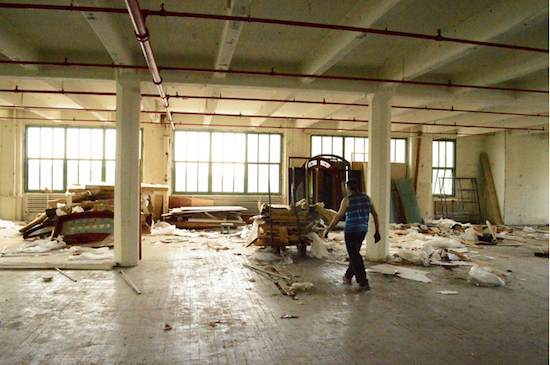“It’s great, as far as I’m concerned,” said Brian Dentz, a local Sunset Park homeowner. “I bought my house a long time ago, and I never expected this to emerge. I’m excited for what might develop.”
New tenants within the site are also hiring on their own, without Industry City’s assistance (often locally as well). A wide range of good-paying jobs are being created for people of varying education backgrounds and skill levels, with many from the local Sunset Park and wider working-class population eligible.
A few common “hub” areas are now open for business (and thriving), but substantial renovations also continue to be performed, including repairs from devastation wrought by Hurricane Sandy.
The site is an active state of transition, with detritus-filled rooms and rubble-strewn lots next to gleaming new renovations.
So what should artists make of this rising attention to a place they had called home? Four dozen of them reportedly lost their studios as a consequence of the property transfer, though a source tells us that many of these may have been unlawful subdivisions, illegal sublets, or both, with the artists involved less than cooperative with the new ownership. And Industry City’s rents are not exorbitant, but comparable to other Brooklyn waterfront properties. Finally, displacing artists with an industrial sector that many political leaders recently requested the mayor expand and reserve is distinguishable from evictions to make way for high end housing.
Nonetheless, the rising cost of living has taken its toll on those at the economic fringes, leaving many media outlets have began to wonder if artists’ days in New York are numbered in general, as they may soon lack a ‘next neighborhood’ to move to.
Some of the evictions were found to be particularly appalling but art-focused media outlets, with claims that the new site owners marketed and heralded the space as perfect for ‘creatives’ and embraced the art world at the same time they were pushing them out. Indeed, common areas are now decorated with a “gritty” feel that pays homage to fringe elements that may have been displaced by the development.
However, a spokesperson for Industry City disputed many of these claims. “A full 25% of Industry City tenants are artists, a number that has grown by 18% since the new partnership began repositioning the property,” a statement read. “The partnership is committed to making Industry City an innovation economy makers community, including a significant role for artists and artisans.”
Five years ago, the location became known as a haven for artists who didn’t mind its worn aesthetics. That trend continued through about 2012, just a year before the sale. The properties have now been dubbed “the SoHo of Sunset Park,” and the wider neighborhood may be catching on as well.
Sunset Park’s transition, however, involves more machinations. A predominantly lower-middle class area, with a largely Latino population from Third Avenue to Seventh, ‘Brooklyn’s Chinatown’ from Seventh to Ninth, and a sprinkling of Italians, Poles and Norwegians everywhere in between, it has endured many transformations: the loss of its historic manufacturing base, several waves of Latino immigration, despair and abandonment during the drug-fueled seventies and eighties, a slow pace of renewal and gentrification with buyouts of rent-controlled tenants and, ironically (or predictably), an attraction to the neighborhood caused by the artists who are now claiming to be displaced.
Industry City ownership hopes to provide a solution that can benefit businesses, the arts, and the local community. The new ownership has gone out of its way to support artists at the site, including by: (1) supporting a group of driven artist tenants who hosted the property’s first Open Studios program in April 2014, which attracted more than 2,000 people to the property’s artist spaces, (2) awarding complimentary studio spaces to tenants affiliated with the arts, including artist Robert Motherwell’s Dedalus Foundation, the Select Fair art festival, and art supply manufacturer Utrecht Linens/Dick Blick, (3) continuing to convert selected large-format former manufacturing spaces into smaller spaces suitable for artists and artisans, (4) hiring a resident artist to make the property more appealing to tenants and visitors through artistic sign-painting and graffiti art, (5) partnering with Groundswell for a significant permanent mural painted by local students, and with a number of local schools on art related programming, and supporting local arts organizations such as Chashama and Groundswell.
So what will Industry City ultimately turn into? It remains to be seen, but for now, the only constant is change.
